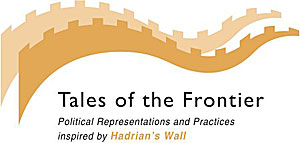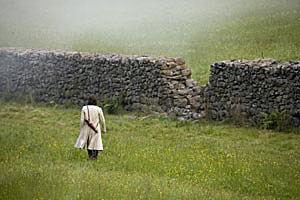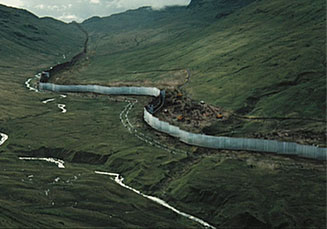
While I was in Durham, this year, I heard a very interesting talk by Richard Hingley on the work that he’d been doing on the Tales of the Frontier project for the last couple of years (it was, actually, one of several very interesting talks that I heard in Durham but this is the one that’s most related to my Where London Stood project). Richard’s talk dealt with the reception of Hadrian’s Wall over time.
Although the Wall had been built by the Roman army around 120 AD, this fact was only conclusively accepted in the nineteenth century. In the time between the fall of the Roman Empire and then, the Wall had been known variously as the “Picts’ Wall,” the “Roman Wall,” or “Adrian’s Wall.” So, changing theories of the Wall’s origins provide one source of instability in the Wall’s meaning and cultural significance. However, Richard’s talk took in a number of different areas: as well as the changing knowledge of the wall’s origins over the centuries, it looked at artistic and literary representations and the unique valences with which their creators had imbued the Wall. The talk’s examples included Michael Drayon’s Jacobean poem Poly-Olbion, William Bell Scott’s 1857 The Romans Cause a Wall to be Built for the Protection of the South (painting currently in Wallington Hall’s collection), Neil Gaiman’s novel Stardust and its movie adaptation, and Neil Marshall’s film Doomsday (2008). Drayton’s Poly-Olbion was (in part at least) a poem about the spirit of place and was, in Richard’s words, “slightly critical of James I’s unification of England and Scotland.” Richard interprets Bell Scott’s painting as a reflection upon loyalty in the British Empire in the wake of the Indian Mutiny. Stardust used the Wall to represent the separation of our rational lives from the mythic. Doomsday has a rebuilt Wall seal off a plague-devastated Scotland from England, while drawing on an established (even clichéd) body of science-fiction images.

I think that there were two main “take home” points in Richard’s argument. First, he suggested that academic disciplines almost always attempt to expel myth and folklore from our understanding of the past and its remains; being literary works, Drayton’s Poly-Olbion and Gaiman’s Stardust both have more freedom to combine “history and story” — they’re less concerned with establishing solid facts. Conversely, archaeological studies of Hadrian’s Wall have become focused on the driest of details, such as determining the sequence in which milecastles and other parts of the Wall were built or when particular legions would have been stationed there.
Of course, there’s absolutely nothing wrong with wanting to establish the sequence of the Wall’s construction or dates for a legion’s presence on a frontier; in fact, this kind of work remains essential to archaeological practice. However, Richard’s second “take home” point is that this elimination of myth and folklore closes an important avenue of potential research. Archaeological understandings of Hadrian’s Wall have had a complicated relationship to popular ones. Yet archaeologists don’t examine how people perceive and perceived the discipline of archaeology, its practitioners, the work that they do, and the impact of all this on the popular imagination. As he highlighted, this is in stark contrast to the intellectual work that some classicists have done on the reception of the classical world and its history, e.g. in cinema. Now, I am sure that this will be something of a shock to those archaeologists who like to consider classicists to be theoretical sticks-in-the-mud. I am also sure that several people will reel off lists of archaeologists who have engaged with reception of the discipline. To head them off at the pass, I’ll mention Cornelius Holtorf’s recent book, Archaeology is a Brand! (off-site review), and a friend’s long-standing course on Archaeology and Popular Culture. And, of course, this is not the first time that Richard’s worked on reception studies — for instance, there’s his book on Roman Officers and English Gentlemen: The Imperial Origins of Roman Archaeology. But Richard’s point is broadly correct: it is a relatively under-explored area.

Not only was the talk extremely illuminating on the history of Hadrian’s Wall itself but it allowed me to see WLS in a new light. The theme of archaeology’s representation had been present in the project, since its inception, but I now realize how my work on representations of the contemporary city as ruin fits in with other archaeologists’ research. I had been, and still am, struggling with how to connect archaeological understandings of site formation with these imaginative depictions of ruin. Richard’s work was extremely helpful and different from the discussions I have seen of pop archaeology because, rather than dealing with the figure of “the Archaeologist” himself or herself (Indiana Jones is a popular … ummm … whipping boy in academic archaeology, while paradoxically an icon of the field), it looked at one monument and how its meanings shifted under the pressures of archaeological and artistic representation.

The different iterations of Hadrian’s Wall are directly comparable to the changing representations of the various ruined Londons and other cities: these ruins become (as-yet-unrealized) archaeological sites that are subject to interpretation and reinterpretation. In some tales, there are actual archaeological excavations: Ronald Wright’s time-travelling protagonist, in A Scientific Romance: A Novel (1997), digs a number of test trenches in an abandoned and overgrown London; the pseudonymous Prof. Blyde Muddersnook’s short story, When the Zealander Comes is in the style of a public presentation of an archaeological excavation’s results (The Strand, September 1911 — reprinted online, here). But the connections to the image of archaeology in the popular imagination are stronger and more deeply ingrained than either of these examples suggest: even where there is no archaeological excavation involved, these ruins are archetypal “Lost Cities.” They are the kinds of archaeological sites that people imagine explorers finding as they stumble out of almost impenetrable jungle — futuristic echoes of Angkor and Tikal.
As with Hadrian’s Wall, a little more critical pressure can go a long way. There are the various ways in which a city might have met its end: simple abandonment, the result of historical cycles of decline and fall, devastation by nuclear or biological weapons. All of these reflect the fears and anxieties of the times in which the work of art (whether literary or visual) emerged. There is also the question of which city appears and the valences that it carries. Capital cities are frequently employed metonymically to stand for the whole of a country or civilization; this goes some way to explaining, I think, the prevalence of representations of ruins of London and Washington. And note how revealing this can be, when the artist or artists behind the representation are from another culture. In the BBC’s TV version of The Tripods trilogy, Paris stands in for France in a show which has been eager to emphasize the journey of the three boys through another country. Not only do the story’s heroes encounter the monumental structures that suggest Paris and “Frenchness” but also some extremely stylish (in 1980’s terms) denizens of the ruins and that most iconically French car, a 2CV. These, then, are the signifiers of “Frenchness” for a British audience: monumental buildings, stylish youths, and an inoperable 2CV.
The USA apparently has a more divided sense of national identity than other countries. Artists from the United States seem to employ the ruins of New York at least as often as they do Washington, DC; New York stands in as a cultural rather than political capital. However, there is yet a third example of a city that is important to US history, one that is rarely depicted in these scenarios and notable for its appearance in Terry Gilliam’s film, Twelve Monkeys. Philadelphia played a key role in the USA’s foundation, hosting the First (1774) and Second (1775) Continental Congresses. As the host of the Second Continental Congress, it saw the signing of the Declaration of Independence. In the film, it’s also the site at which a civilization-toppling plague was released. That this city played such major roles in the foundation of the United States and its fall cannot be coincidental. It’s also interesting to see what Gilliam includes as key locations for his characters to explore in the film. He avoids leading us to the Liberty Bell or any other obvious heritage sites; instead, we see the main protagonist wandering in and around City Hall and the ruins of a famous early twentieth century department store. Why these particular buildings and not others?
So, a beginning to interpretation rather than an end — but it’s a beginning that underscores the role of academic communities. It’s hard to imagine that I’d have reached precisely this point, without hearing Richard’s talk, and Where London Stood now has an obvious intellectual “home” in studies in the reception of archaeology. I’ll have more to say about the WLS project, the reception of archaeology, and the importance of academic communities in future posts.

One thought on “Studies in the Reception of Archaeology”